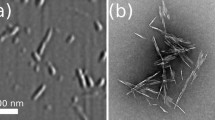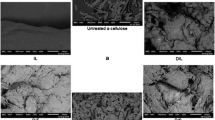Abstract
All-cellulose composites were prepared by partly dissolving microcrystalline cellulose (MCC) in an 8.0 wt% LiCl/DMAc solution, then regenerating the dissolved portion. Wide-angle X-ray scattering (WAXS) and solid-state 13C NMR spectra were used to characterize molecular packing. The MCC was transformed to relatively slender crystallites of cellulose I in a matrix of paracrystalline and amorphous cellulose. Paracrystalline cellulose was distinguished from amorphous cellulose by a displaced and relatively narrow WAXS peak, by a 4 ppm displacement of the C-4 13C NMR peak, and by values of T2(H) closer to those for crystalline cellulose than disordered polysaccharides. Cellulose II was not formed in any of the composites studied. The ratio of cellulose to solvent was varied, with greatest consequent transformation observed for c < 15%, where c is the weight of cellulose expressed as % of the total weight of cellulose, LiCl and DMAc. The dissolution time was varied between 1 h and 48 h, with only small additional changes achieved by extension beyond 4 h.







Similar content being viewed by others
Abbreviations
- MCC:
-
Microcrystalline cellulose
- DMAc:
-
N,N-dimethylacetamide
- NMR:
-
nuclear magnetic resonance
- WAXS:
-
Wide-angle X-ray scattering
References
Bledzki AK, Gassan J (1999) Composites reinforced with cellulose based fibres. Progr Polymer Sci 24:221–274
Bock B, Bock S, Fengel D (1991) NMR parameters of cellulose in TFA solution. Holzforschung 45:321–324
Conio G, Corazza P, Bianci E, Taldi A, Ciferri A (1984) Phase-equilibria of cellulose in N,N-dimethylacetamide/LiCl solutions. J Polymer Sci Part C - Polymer Lett 22:273–277
Dupont A-L (2003) Cellulose in lithium chloride/N,N-dimethylacetamide, optimisation of a dissolution method using paper substrates and stability of the solutions. Polymer 44:4117–4126
El-Kafrawy A (1982) Investigation of the cellulose/LiCl/dimethylacetamide and cellulose/LiCl/N-methyl-2-pyrrolidone solutions by 13C NMR spectroscopy. J Appl Polymer Sci 27:2435–2443
Gindl W, Keckes J (2004) Tensile properties of cellulose acetate butyrate composites reinforced with bacterial cellulose. Composites Cellulose Technol 64:2407–2413
Gindl W, Keckes J (2005) All-cellulose nanocomposite. Polymer 46:10221–10225
Gindl W, Martinschitz KJ, Boesecke P, Keckes J (2006a) Structural changes during tensile testing of an all-cellulose composite by in situ synchrotron X-ray diffraction. Composites Sci Technol 66:2639–2647
Gindl W, Schöberl T, Keckes J (2006b) Structure and properties of a pulp fibre-reinforced composite with regenerated cellulose matrix. Appl Phys A – Mater Sci Processing 83:19–22
Gjønnes J, Norman N (1958) The use of half width and position of the lines in the X-ray diffractograms of native cellulose to characterize the structural properties of the samples. Acta Chemica Scandinavica 12:2028–2033
Gjønnes J, Norman N (1960) X-ray investigations on cellulose II and mixtures of cellulose I and II. 2. Lateral order in cellulose II. Acta Chemica Scandinavica 14:689–691
Glasser WG, Taib R, Jain RK, Kander R (1999) Fiber-reinforced cellulosic thermoplastic composites. J Appl Polymer Sci 73:1329–1340
Hemmingson JA, Newman RH (1995) Changes in molecular ordering associated with alkali treatment and vacuum drying of cellulose. Cellulose 2:71–82
Hirai A, Horii F, Kitamaru R (1990) Carbon-13 spin-lattice relaxation behaviour of the crystalline and noncrystalline components of native and regenerated celluloses. Cellulose Chem Technol 24:703–711
Hong Y-K, Chung K-H, Lee W-S (1998) Structure of regenerated cellulose fibers from DMAc/LiCl solution. Textile Res J 68:65–69
Horii F, Hirai A, Kitamaru R (1987) Cross-polarization-magic angle spinning carbon-13 NMR approach to the structural analysis of cellulose. In: Atalla RH (ed) The structures of cellulose: characterization of the solid states. American Chemical Society, Washington DC, p 119
Ioelovich M, Larina E (1999) Parameters of crystalline structure and their influence on the reactivity of cellulose I. Cellulose Chem Technol 33:3–12
Ishii D, Tatsumi D, Matsumoto T (2003) Effect of solvent exchange on the solid structure and dissolution behavior of cellulose. Biomacromolecules 4:1238–1243
Isogai A, Usuda M, Kato T, Uryu T, Atalla RH (1989) Solid-state CP/MAS 13C NMR study of cellulose polymorphs. Macromolecules 22:3168–3172
Kondo T, Togawa E, Brown Jr RM (2001) “Nematic ordered cellulose”: a concept of glucan chain association. Biomacromolecules 2:1324–1330
Kroon-Batenburg LMJ, Kroon J, Northolt MG (1990) Theoretical studies on β(1→4) glucose oligomers as models for native and regenerated cellulose fibres. Das Papier 44:640–647
Lu JZ, Wu QL (2000) Chemical coupling in wood fiber and polymer composites: A review of coupling agents and treatments. Wood Fiber Sci 32:88–104
Mann J (1962) Modern methods of determining crystallinity in cellulose. Pure Appl Chem 5:91–105
McCormick CL, Callais PA, Brewer Jr HH (1985) Solution studies of cellulose in lithium chloride and N,N-dimethylacetamide. Macromolecules 18:2394–2401
Murdock CC (1930) The form of the X-ray diffraction bands for regular crystals of colloidal size. Phys Rev 35:8–23
Newman RH (1999) Estimation of the lateral dimensions of cellulose crystallites using 13C NMR signal strengths. Solid State Nuclear Magnetic Resonance 15:21–29
Newman RH, Davies LM, Harris PJ (1996) Solid-state 13C nuclear magnetic resonance characterization of cellulose in the cell walls of Arabidopsis thaliana leaves. Plant Physiol 111:475–485
Newman RH, Davidson TC (2004) Molecular conformations at the cellulose-water interface. Cellulose 11:23–32
Newman RH, Hemmingson JA (1995) Carbon-13 NMR distinction between categories of molecular order and disorder in cellulose. Cellulose 2:95–110
Nishino T, Matsuda I, Hirao K (2004) All-cellulose composite. Macromolecules 37:7683–7687
Nishino T, Takano K, Nakamae K (1995) Elastic modulus of the crystalline regions of cellulose polymorphs. J Polymer Sci: Part B: Polymer Phys 33:1647–1651
Schroeder LR, Gentile VM, Atalla RH (1986) Nondegradative preparation of amorphous cellulose. J Wood Chem Technol 6:1–14
Segal L, Creely JJ, Martin AE, Conrad CM (1959) An empirical method for estimating the degree of crystallinity of native cellulose using the X-ray diffractometer. Textile Res J 29:786–794
Striegel AM (2002) Advances in the understanding of the dissolution mechanism of cellulose in DMAc/LiCl. J Chilean Chem Soc 48:73–77
Sugiyama J, Vuong R, Chanzy H (1991) Electron diffraction study on the two crystalline phases occurring in native cellulose from an algal cell wall. Macromolecules 24:4168–4175
Tsuda Y, Mukoyama S (1957) The formation of cellulose IV in the viscose spinning. Bull Chem Soc Jpn 30:718–720
Wada M, Heux L, Sugiyama J (2004) Polymorphism of cellulose I family: reinvestigation of cellulose IV. Biomacromolecules 5:1385–1391
Yano H, Sugiyama J, Nakagaito AN, Nogi M, Matsuura T, Hikita M, Handa K (2005) Optically transparent composites reinforced with networks of bacterial nanofibers. Advanced Materials 17:153–155
Yamashiki T, Matsui T, Kowsaka K, Saitoh M, Okajima K, Kamide K (1992) New class of cellulose fiber spun from the novel solution of cellulose by wet spinning method. J Appl Polym Sci 44:691–698
Acknowledgments
The authors would like to thank the Biopolymer Network Limited (New Zealand) for financial assistance and technical support provided to this project. One of the authors (MPS) would like to thank the Brian Mason Scientific and Technical Trust for financial assistance. The authors thank Mr. S. Hill (Scion Limited, Rotorua, New Zealand) for assistance with solid-state NMR and Mr. S. Brown for acquisition of the WAXS patterns.
Author information
Authors and Affiliations
Corresponding author
Rights and permissions
About this article
Cite this article
Duchemin, B.JC.Z., Newman, R.H. & Staiger, M.P. Phase transformations in microcrystalline cellulose due to partial dissolution. Cellulose 14, 311–320 (2007). https://doi.org/10.1007/s10570-007-9121-4
Received:
Accepted:
Published:
Issue Date:
DOI: https://doi.org/10.1007/s10570-007-9121-4




